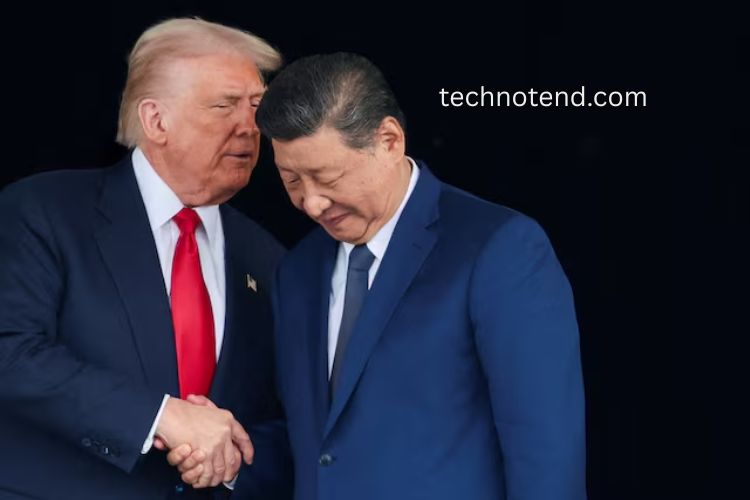On November 1, the White House released key details of the agreement U.S. President Donald Trump reached with Chinese President Xi Jinping in Busan, South Korea. The deal marks a major step in de-escalating the ongoing trade tensions between the world’s two largest economies. It includes U.S. tariff reductions, a pause on China’s rare-earth export controls, and renewed Chinese purchases of American soybeans.
- Tariff Reduction on Fentanyl-Related Goods
- Pause on China’s Rare-Earth Export Controls
- U.S. Export Controls Paused
- China Commits to Soybean and Agricultural Purchases
- Port Fees and Maritime Measures Paused
- Cooperation on Fentanyl Trafficking
- Economic and Political Implications
- Frequently Asked Questions:
- What was the main purpose of the Trump-Xi agreement?
- Which tariffs were affected by the deal?
- How does the agreement impact rare-earth minerals and technology exports?
- Did the deal include agricultural commitments?
- What measures were agreed upon to combat fentanyl trafficking?
- How long will the trade truce last?
- What sectors benefit most from the agreement?
- conclusion
This agreement averts Trump’s threatened 100% tariff on Chinese goods and extends a delicate trade truce for approximately one year. The deal also introduces measures aimed at curbing the flow of fentanyl from China to the United States, addressing a critical public health crisis.
Read More: http://technotend.com/sets-sights-on-game-changing-5-billion/
Tariff Reduction on Fentanyl-Related Goods
Under the deal, the U.S. will cut the 20% tariff on Chinese goods linked to fentanyl precursor chemicals to 10%. This reduction lowers the overall U.S. tariff rate on Chinese imports from roughly 57% to 47%. The reduction includes prior duties imposed during Trump’s first term and a 10% reciprocal tariff introduced in April.
This move is designed to ease trade tensions while maintaining pressure on China to take concrete steps against the illegal fentanyl trade, which has contributed to tens of thousands of overdose deaths in the United States annually.
Pause on China’s Rare-Earth Export Controls
China agreed to a one-year pause on export controls affecting rare-earth minerals and magnets. These materials are critical for automobiles, aircraft, and military applications and have been a key leverage point in Beijing’s trade strategy.
The U.S. also benefits from China’s commitment to issue general licenses for exports of rare earths, gallium, germanium, antimony, and graphite. According to the White House, this effectively removes restrictions China imposed in April 2025 and October 2022.
Additionally, China suspended all retaliatory tariffs announced since March 4, covering U.S. goods such as chicken, wheat, corn, cotton, sorghum, soybeans, pork, beef, and dairy products. Non-tariff countermeasures, including listings of certain American companies as unreliable entities, will also be paused.
U.S. Export Controls Paused
The Trump administration agreed to a one-year pause on an expanded Commerce Department blacklist targeting companies prohibited from purchasing U.S. technology goods, including semiconductor manufacturing equipment.
This pause prevents the automatic inclusion of firms more than 50% owned by companies already on the blacklist, a measure that would have significantly affected Chinese businesses and restricted thousands of exports.
China Commits to Soybean and Agricultural Purchases
China pledged to purchase at least 12 million metric tons of U.S. soybeans in the final two months of 2025 and at least 25 million metric tons annually over the next three years. In addition, China agreed to resume imports of U.S. sorghum and hardwood logs.
The renewed purchases come after China had largely stopped buying U.S. soybeans this autumn, opting for alternatives from Brazil and Argentina. While the commitments restore previous levels of U.S. exports, analysts note they fall short of the ambitious targets set under the 2020 “Phase One” trade deal, which were disrupted by the COVID-19 pandemic.
China also agreed to facilitate trade from chipmaker Nexperia’s Chinese facilities, enabling the production and export of essential legacy semiconductors. Market-based tariff exclusions for U.S. imports will remain valid until December 31, 2026, and antitrust, anti-monopoly, and anti-dumping investigations against U.S. semiconductor firms will be terminated.
Port Fees and Maritime Measures Paused
The agreement addresses trade tensions in the maritime sector. China will remove retaliatory measures against U.S. shipping linked to Section 301 investigations, while the Trump administration will pause new port fees on Chinese-built, -owned, and -flagged ships for one year.
These fees, which took effect on October 14 alongside 100% tariffs on Chinese ship-to-shore cranes, had disrupted cargo flows and increased shipping costs. Both nations will continue negotiations on port fees and explore collaboration with South Korea and Japan to revitalize U.S. shipbuilding.
Cooperation on Fentanyl Trafficking
A central element of the deal is combating fentanyl trafficking. China agreed to implement significant measures to halt the flow of fentanyl to the United States. This includes controlling the export of certain precursor chemicals and strictly regulating others worldwide.
U.S. and Chinese working groups will set measurable targets to track progress in reducing fentanyl shipments. The tariff reductions on fentanyl-related goods remain conditional, contingent on China’s actions to curb the illegal drug trade.
Economic and Political Implications
The Trump-Xi agreement represents a strategic win for both nations. For the U.S., the deal protects American farmers, stabilizes technology supply chains, and reduces tariffs on key imports. For China, the truce avoids escalation, secures market access, and prevents further economic disruption.
Financial markets responded positively to the announcement, fueled by optimism over a potential end to prolonged U.S. government shutdowns. However, investors remain cautious due to high valuations in AI and technology stocks.
The agreement also highlights the growing intersection of trade and public health, with fentanyl regulation emerging as a critical focus. By linking tariffs to concrete actions on drug control, the U.S. incentivizes China to enforce stricter measures against the illegal opioid trade.
Frequently Asked Questions:
What was the main purpose of the Trump-Xi agreement?
The agreement aimed to de-escalate the U.S.-China trade war by reducing tariffs, pausing export controls, and addressing the flow of fentanyl from China to the U.S.
Which tariffs were affected by the deal?
The U.S. cut tariffs on Chinese goods related to fentanyl precursor chemicals from 20% to 10%. Overall U.S. tariffs on Chinese imports fell from roughly 57% to 47%.
How does the agreement impact rare-earth minerals and technology exports?
China agreed to a one-year pause on export controls for rare-earth minerals and magnets. The U.S. also paused expanded export restrictions on Chinese companies, ensuring critical technology can continue to flow.
Did the deal include agricultural commitments?
Yes, China committed to purchasing at least 12 million metric tons of U.S. soybeans by the end of 2025 and 25 million metric tons annually over the next three years. It will also resume buying U.S. sorghum and hardwood logs.
What measures were agreed upon to combat fentanyl trafficking?
China pledged to control the export of certain precursor chemicals and implement measures to curb fentanyl shipments to the U.S. Working groups from both countries will track progress.
How long will the trade truce last?
The agreement establishes a truce of roughly one year, providing both nations time to negotiate longer-term solutions.
What sectors benefit most from the agreement?
Key beneficiaries include U.S. farmers, technology and semiconductor industries, and sectors relying on rare-earth minerals. Shipping and maritime trade also see temporary relief from tariffs and port fees.
conclusion
The Trump-Xi agreement marks a pivotal moment in U.S.-China relations, blending trade diplomacy with public health and technological security. By reducing tariffs, pausing export controls, and addressing the fentanyl crisis, both nations have created a framework for stability and cooperation over the next year. U.S. farmers, technology sectors, and consumers benefit from eased trade restrictions, while China maintains market access and economic stability. While challenges remain in enforcement and long-term commitments, the deal demonstrates that strategic negotiation and compromise can produce meaningful outcomes. As global markets and policymakers watch closely, this agreement may serve as a model for balancing economic interests with public health and geopolitical priorities, reinforcing the importance of diplomacy in shaping global politics.















